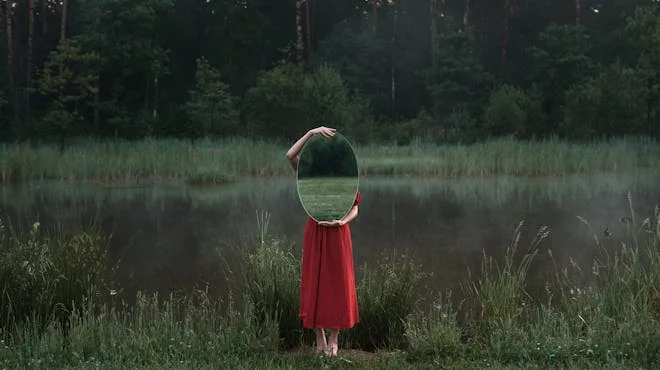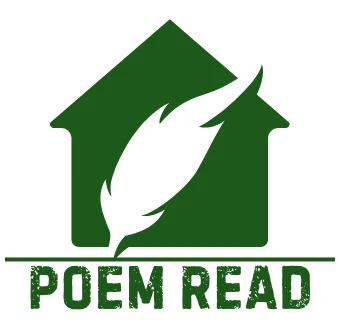
Mirror” by Sylvia Plath is a powerful and thought-provoking poem that explores the complex themes of self-identity, aging, and the harsh realities of life. As one of the most celebrated American poets of the 20th century, Sylvia Plath’s works continue to captivate readers with their raw emotions and introspective exploration. In this blog post, we will delve into the subject of the poem, provide an overview of the author, discuss the context, explore the theme and tone, and analyze the form and structure of “Mirror.”
Mirror I am silver and exact. I have no preconceptions. Whatever I see I swallow immediately Just as it is, unmisted by love or dislike. I am not cruel, only truthful‚ The eye of a little god, four-cornered. Most of the time I meditate on the opposite wall. It is pink, with speckles. I have looked at it so long I think it is part of my heart. But it flickers. Faces and darkness separate us over and over. Now I am a lake. A woman bends over me, Searching my reaches for what she really is. Then she turns to those liars, the candles or the moon. I see her back, and reflect it faithfully. She rewards me with tears and an agitation of hands. I am important to her. She comes and goes. Each morning it is her face that replaces the darkness. In me she has drowned a young girl, and in me an old woman Rises toward her day after day, like a terrible fish.
Content
The Subject of “Mirror” by Sylvia Plath
The subject of the poem is the relationship between a woman and a mirror, which represents the truth about her appearance and identity. “Mirror” revolves around the central theme of self-reflection and the search for one’s true identity. The poem personifies a mirror, which serves as a metaphor for self-examination and introspection.
Through the mirror’s perspective, Plath explores the transformative journey of the narrator as she confronts the harsh realities of aging and the loss of beauty. The poem is divided into two stanzas, with each stanza presenting the perspective of the mirror.
First Stanza
The first stanza describes the mirror as a clear and honest object that reflects everything without distortion or judgment. The mirror asserts that it has no preconceptions or preferences. It states that it is not cruel or kind, but simply truthful. The mirror also reveals that, aside from the brief moments when faces and darkness come in between them, it has been looking at the wall opposite it for the majority of the time.
Second Stanza
The second stanza shifts the focus to the woman who looks in the mirror every day. The mirror says that it has become a lake, a metaphor for a deeper and more complex reflection. The woman bends over the lake and searches for her true self, but she is unhappy with what she sees. The mirror faithfully depicts the effects of aging and the passage of time, which trouble her. The mirror says that it is important to her, like a god or a voice of conscience.
Additionally, the mirror claims that it is honest but not cruel and that the woman’s tears and agitation are a result of her own self-judgment. Finally, the poem ends with a striking image of the woman seeing an old woman rise toward her like a terrible fish, suggesting that she is horrified by her own appearance and mortality.
About the Author of “Mirror”
Sylvia Plath was born on October 27, 1932, in Boston, Massachusetts. She was a gifted and ambitious writer who published her first poem at the age of eight. She attended Smith College and won a Fulbright scholarship to study at Cambridge University in England. There, she met and married the poet Ted Hughes, with whom she had two children.
Plath suffered from depression and attempted suicide several times in her life. She also struggled with the expectations and pressures of being a woman, a mother, and a writer in the 1950s and 1960s. Subsequently, Plath separated from Hughes in 1962 after discovering his affair with another woman. She moved to London with her children and wrote some of her most powerful and acclaimed poems, including “Daddy”, “Lady Lazarus”, and “Ariel”.
She also wrote a semi-autobiographical novel, The Bell Jar, which was published under a pseudonym in 1963. On February 11, 1963, Plath committed suicide by gassing herself in her kitchen oven. She was 30 years old. Her death sparked controversy and a cult following around her work, which was often seen as a reflection of her personal life and emotions.
Context of “Mirror” by Sylvia Plath
“Mirror” is one of the poems that Plath wrote in the last months of her life, when she was living in a rented flat in London. The poem is part of a collection called Crossing the Water, which was published posthumously in 1971. The collection contains poems that explore themes of identity, femininity, motherhood, nature, and death.
Many critics have interpreted “Mirror” as a poem that expresses Plath’s own feelings of insecurity, dissatisfaction, and fear of aging and dying. They have also pointed out the parallels between the mirror and Plath’s writing, which was her way of reflecting and revealing the truth about herself and the world.
However, some critics have also argued that the poem should not be read as a mere autobiography but as a universal statement about the human condition and the role of art. They have suggested that the poem is not only about Plath but about any woman who faces the challenges of self-image, self-worth, and self-knowledge in a society that values appearance over substance.
They have also proposed that the poem is not only about a mirror but about any object or medium that can offer a truthful and objective perspective on reality, such as a camera, a painting, or a poem. Therefore, it is important to consider these factors when analyzing the poem, as they provide valuable insights into the emotions and themes explored.
The Theme and Tone of “Mirror” by Sylvia Plath
The theme of the poem is the contrast between appearance and reality and the quest for self-knowledge and self-acceptance. The poem explores how a woman relies on a mirror to tell her the truth about her physical appearance and her identity, but she is unhappy and dissatisfied with what she sees. It also shows how the mirror reflects the passage of time and the inevitability of aging and death, which the woman tries to deny or ignore. Furthermore, the poem suggests that the woman is trapped in a cycle of self-scrutiny and self-judgment and that she needs to find a way to accept herself and her reality.
The tone of the poem is detached, objective, and unemotional. The poem is written from the point of view of the mirror, which claims to be impartial and honest but not cruel or kind. The mirror does not express any feelings or opinions, but simply states what it sees and knows. The mirror also does not show any sympathy or empathy for the woman, who is clearly suffering and unhappy.
The mirror’s tone creates a sense of distance and coldness, which contrasts with the woman’s emotional turmoil and desperation. The tone also implies that the mirror is not a reliable source of truth, as it only reflects the surface and not the depth of the woman’s being. The tone also suggests that the mirror is not a friend or a helper, but a witness and a judge of the woman’s life.
The Form or Structure of “Mirror” by Sylvia Plath
The poem “Mirror” by Sylvia Plath has a simple and symmetrical form or structure. The poem consists of two stanzas, each with nine lines. The first stanza is about the mirror, and the second stanza is about the woman. The poem follows a free verse style, which means that it does not have a regular rhyme scheme or meter. However, the poem does have some elements of rhyme, rhythm, and punctuation that create a sense of order and harmony.
Rhyme Scheme of “Mirror” by Sylvia Plath
The poem uses slant rhyme, which is a type of rhyme that is not exact or perfect but close enough to create an effect. For example, the words “unmisted” and “faces” in the first stanza and “day” and “faithfully” in the second stanza rhyme partially but not completely.
The poem also uses internal rhyme, which is a type of rhyme that occurs within a line rather than at the end. For example, the words “swallow” and “wallow” in the second stanza rhyme within the same line. The poem also uses assonance, which is a type of rhyme that involves the repetition of vowel sounds. For example, the words “eye” and “liars” in the first stanza and “lake” and “face” in the second stanza share the same vowel sound.
The use of syllables and stresses in the poem also creates a subtle rhythm. The poem has an average of ten syllables per line, which gives it a balanced and consistent flow. It also has a pattern of stresses, which are the syllables that are emphasized or pronounced louder than others. The poem alternates between iambic and trochaic feet, which are units of two syllables, one unstressed and one stressed, or vice versa. For example, the first line of the poem says, “I am silver and exact. I have no preconceptions.” has an iambic-trochaic pattern. It can be shown as:
I am / sil VER / and ex / ACT. I / have no / pre CON / cep TIONS.
Punctuations in “Mirror” by Sylvia Plath
The poem uses periods, commas, and dashes to create different effects. Periods are used to end sentences and create a sense of finality or closure. Furthermore, commas are used to separate clauses and create a sense of continuity or connection. For example, the last line of the poem, “In me she has drowned a young girl, and in me an old woman rises toward her day after day, like a terrible fish.”, uses a dash to create a sense of continuity and connection. The comma also suggests that the woman’s transformation from a young girl to an old woman is gradual and inevitable, rather than sudden and shocking
The poem’s form or structure reflects its theme and tone. Additionally, the poem’s simple and symmetrical form or structure contrasts with its complex and disturbing content. Furthermore, the use of slant rhyme, internal rhyme, and assonance creates a sense of harmony and beauty, but also of ambiguity and uncertainty.
The poem’s use of syllables and stresses creates a sense of rhythm and order, but also of tension and conflict. Concurrently, the use of punctuation creates a sense of clarity and precision, but also of interruption and disruption. The poem’s form or structure shows how the mirror, and the woman are both similar and different, and how they both seek and resist the truth.
Line-by-line Analysis of “Mirror” by Sylvia Plath
Stanza 1
I am silver and exact. I have no preconceptions.
This opening line sets the tone for the poem, establishing the mirror’s identity and its impartial nature. “Silver and exact” suggests the mirror’s clarity and precision, devoid of subjective biases or preconceived notions. Thus, it presents itself as an objective observer, free from human emotions or judgments.
Whatever I see I swallow immediately
The mirror metaphorically “swallows” whatever it reflects, emphasizing its passive role in reflecting reality without distortion or alteration. This line highlights the mirror’s immediacy in reflecting images, indicating its instantaneous perception and lack of conscious filtering.
Just as it is, unmisted by love or dislike.
Here, the mirror emphasizes its neutrality, indicating that it reflects without the influence of emotions like love or dislike. It portrays reality “just as it is,” devoid of any sentimental or emotional overlay. Therefore, this line underscores the mirror’s objectivity and detachment from human sentiments.
I am not cruel, only truthful‚
This line further underscores the mirror’s commitment to truthfulness. It claims that an unwavering commitment to accuracy, not cruelty, is what drives its reflections. It suggests that while the mirror may reveal harsh truths, its intention is not to inflict harm but to present reality as it is.
The eye of a little god, four-cornered.
Here, the poem metaphorically likens the mirror to a godly entity, albeit on a small scale. The “four-cornered” description emphasizes its geometric shape but also alludes to the idea of completeness and totality, suggesting that the mirror sees everything within its frame with God-like omniscience.
Most of the time I meditate on the opposite wall.
This line introduces the mirror’s habitual contemplation of its surroundings, particularly the opposite wall. Hence, it implies a sense of introspection or deep reflection, as the mirror consistently gazes upon the wall opposite to it, perhaps pondering its own existence or the world beyond its surface.
It is pink, with speckles. I have looked at it so long
This description of the opposite wall adds a concrete detail to the poem, depicting it as pink with speckles. The mirror’s prolonged observation of the wall suggests a sense of familiarity or intimacy with its surroundings, hinting at a long-standing relationship between the mirror and its environment.
I think it is part of my heart. But it flickers.
The mirror’s contemplation of the wall leads it to perceive a connection, likening it to a part of its own being, possibly suggesting a sense of emotional attachment or identification. However, the mention of the wall flickering introduces an element of uncertainty or instability, disrupting the mirror’s sense of self.
Faces and darkness separate us over and over.
This line encapsulates the recurring cycle of separation between the mirror and the opposite wall, symbolizing the division between reflection and reality. The mention of “faces and darkness” hints at the transient nature of the images reflected and the persistent presence of shadows or obscurities that obscure clarity.
Some of the techniques and figures of speech used in the first stanza of “Mirror” by Sylvia Plath
Metaphor
The mirror compares itself to a god and an eye, which are both metaphors for its power and vision.
Simile
The mirror says that it swallows whatever it sees immediately, just as it is, which is a simile that compares its reflection to a process of ingestion or consumption.
Hyperbole
The mirror exaggerates its truthfulness and objectivity by saying that it has no preconceptions and that it is unmisted by love or dislike.
Personification
The mirror gives itself human qualities, such as having a heart, meditating, and thinking.
Anthropomorphism
The mirror gives itself animal qualities, such as swallowing and having an eye.
Apostrophe
The mirror addresses the wall as if it were a person and says that it is a part of its heart.
Imagery
The mirror creates a vivid image of the wall, which is pink with speckles, and of the faces and the darkness, which separate them over and over.
Alliteration
The mirror uses words that begin with the same consonant sound, such as “silver and exact”, “swallow immediately”, and “cruel, only truthful”.
Enjambment
The mirror uses lines that run over to the next line without a pause. For example, “I am not cruel, only truthful / The eye of a little god, four-cornered.” and “I think it is a part of my heart. But it flickers.”
Caesura
The mirror uses pauses within a line, such as “Whatever I see I swallow immediately / Just as it is, unmisted by love or dislike.” and “Faces and darkness separate us over and over.”
Stanza 2

Now I am a lake. A woman bends over me,
The metaphor shifts from a mirror to a lake, expanding the imagery to include water imagery. Furthermore, the introduction of a woman bending over the lake suggests an intimate interaction, as she peers into its depths, perhaps searching for her own reflection or seeking answers within its surface.
Searching my reaches for what she really is.
The woman’s action of searching the lake’s depths implies a quest for self-discovery or self-understanding. By looking into the lake, she seeks to uncover her true essence beyond superficial appearances, suggesting a desire for authenticity or inner truth.
Then she turns to those liars, the candles or the moon.
The woman’s turning away from the lake to “candles or the moon” suggests a disillusionment with artificial sources of illumination or guidance. Unlike the mirror/lake, which reflects truthfully, these sources are described as “liars,” implying deception or falsehood in their portrayal of reality.
I see her back, and reflect it faithfully.
Despite the woman’s turning away, the lake/mirror faithfully reflects her image, underscoring its role as a reliable reflector of truth. This line emphasizes the mirror’s passive nature in faithfully mirroring whatever is presented before it, regardless of the subject’s actions or intentions.
She rewards me with tears and an agitation of hands.
The woman’s emotional response to her reflection in the mirror/lake is depicted through tears and agitation of hands, suggesting a complex mix of emotions such as sadness, frustration, or introspection. Her reaction underscores the mirror’s significance as a catalyst for self-examination and emotional reckoning.
I am important to her. She comes and goes.
The mirror/lake’s importance to the woman is highlighted, suggesting that it plays a significant role in her life, perhaps as a tool for self-reflection or a source of emotional validation. The woman’s periodic visits imply a recurrent need for self-examination or emotional solace provided by the mirror/lake.
Each morning it is her face that replaces the darkness.
This line reflects the woman’s daily ritual of confronting her reflection in the mirror/lake, symbolizing a recurring cycle of self-discovery or self-confrontation. The mention of “darkness” being replaced by her face suggests a metaphorical journey from ignorance or obscurity to self-awareness or enlightenment.
In me she has drowned a young girl, and in me an old woman
This line metaphorically depicts the mirror/lake as a repository of the woman’s past selves, symbolizing the process of personal transformation and growth. The imagery of “drowning” suggests a metaphorical immersion or surrender of previous identities, allowing for the emergence of new ones over time.
Rises toward her day after day, like a terrible fish.
The final line evokes a haunting image of the woman’s evolving identity rising from the depths of the mirror/lake, likened to a “terrible fish.” This metaphor suggests a sense of discomfort or unease associated with the process of self-discovery and the confrontation of one’s true nature, hinting at the complexities of personal growth and introspection.
Some of the techniques and figures of speech used in the second stanza of “Mirror” by Sylvia Plath
Metaphor
The mirror compares itself to a lake, which is a metaphor for a deeper and more complex reflection.
Symbolism
The candles and the moon are symbols of artificial or natural light sources that can alter or distort the reality that the mirror shows.
Irony
The mirror says that the woman rewards it with tears and an agitation of hands, which is ironic because the mirror expects gratitude or appreciation, not sorrow or anger.
Personification
The mirror gives itself human qualities, such as being important, faithful, and seeing.
Anthropomorphism
The mirror gives itself animal qualities, such as being a lake.
Imagery
The mirror creates a vivid image of the woman’s back, tears, hands, and face, and the old woman rising like a terrible fish.
Assonance
The mirror uses words that share the same vowel sound, such as “lake” and “face”, “reaches” and “really”, and “drowned” and “old”.
Dissonance
The mirror uses words that create a harsh or unpleasant sound, such as “agitation”, “drowned”, and “terrible”.
Juxtaposition
The mirror places contrasting words or images next to each other, such as “liars” and “faithfully”, “darkness” and “face”, and “young girl” and “old woman”.
Repetition
The mirror repeats the word “in me” twice, which emphasizes its role and influence in the woman’s life.
Allegory
The mirror tells a story that has a deeper or hidden meaning, which is the woman’s struggle with her self-image and self-worth.
Simile
The mirror compares the old woman to a terrible fish, which is a simile that creates a sense of horror and disgust.
Exaggeration
The mirror exaggerates the woman’s reaction and appearance by using words such as “tears”, “agitation”, and “terrible”.
Enjambment
The mirror uses lines that run over to the next line without a pause, such as “Searching my reaches for what she really is.” and “In me she has drowned a young girl, and in me an old woman”.
Caesura
The mirror uses pauses within a line, such as “Then she turns to those liars, the candles or the moon.” and “I am important to her. She comes and goes.”
Interactive Summary of “Mirror” by Sylvia Plath
“Mirror” evokes a range of emotions, including introspection, melancholy, and a sense of vulnerability. The tone conveys the narrator’s deep-seated insecurities and fear of losing her youth and beauty. The poet’s intention is to provoke self-reflection and challenge societal norms surrounding beauty and aging. The target audience for this poem is anyone who grapples with issues of self-identity and the pressures of conforming to societal standards. Reading “Mirror” can evoke a sense of empathy and self-awareness, as it forces us to confront our own insecurities and the fleeting nature of physical beauty.
In conclusion, “Mirror” is a poignant and introspective poem that delves into the complexities of self-identity and the harsh realities of aging. Through vivid imagery and powerful metaphors, Sylvia Plath invites readers to reflect on their own perceptions of beauty and the search for true identity. This timeless piece of literature continues to resonate with audiences, offering a profound exploration of the human condition.
RELATED POSTS
View all



